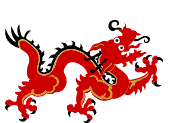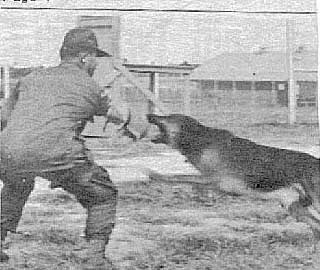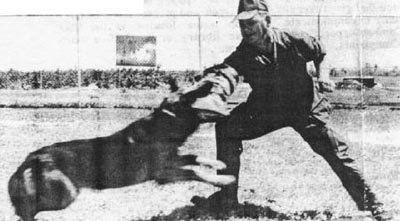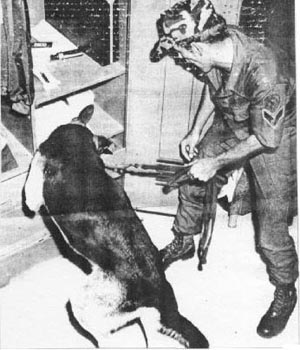The 635th Security Police Squadron’s K-9 Section is building a new image for the fierce sentry dogs that help guard U-Tapao Air Field. They have even given them a new name - patrol dogs. Instead of being taught to distrust anyone other than their handlers, the wiry, sharp-toothed German Shepherds are conditioned to work under control in harmony with a number of different persons in both combat and non-combat situations. The process of tempering four sentry dogs’ notorious dispositions and giving them required extra training, began here five weeks ago. The transformation should be completed August 10, when four more dogs will begin training. A fully trained patrol dog has all of the capabilities of the sentry dog for detection of intruders and for aggressive backup of his human handler. His developed ability also permits him to recognize different persons as allies or enemies, and thus be able to alert his handler to danger without revealing his position. Even off-leash, a patrol dog will not attack an individual unless commanded or unless his handler is attacked. Obedience is so highly developed that even under agitation he will not attack until the handler give the command. Then the patrol dog attacks with the same ferocity as the sentry dog, but in contrast with the sentry dog, will break off attack at his handler’s command. The initial training that a dog receives is crowd familiarization. It consists entirely of surrounding the dog with people that talk to him and work around him, until the dog loses his apprehension towards strangers. When completed, a patrol dog can accompany his handler through populated areas without danger to bystanders during ordinary law enforcement operations. Whereas the “agitator” had to wear thick padding during attack exercises for sentry dogs, agitators now cover their arms only with a thin canvas sheet to give the dog the feel of flesh and bones of the arm. In this way the patrol dog can be taught to hold his victim rather than tear him up. Eventually, the dog will even be able to pick out his foe in a crowd when his handler gives the command to attack. The dogs’ training also includes tracking and crawling. Sentry dogs relied entirely on “air scent” when tracking, which could make for rough going on windy days. The patrol dogs are being taught to track “ground scent”, which is harder as only the bottom of a person’s shoe touches the ground. On command, the patrol dog will belly crawl with his handler, which could be essential if he had to advance toward an enemy under fire. One of the more unique types of training is the building search. Here a handler can turn his dog loose at the entrance of a building and the dog will carefully check out each room for hidden persons. If the dog discovers a person armed with a gun, he will immediately attack. If the person is armed with a club or knife, or is unarmed, he will bark until his handler arrives. Although harder to train, the more versatile patrol dogs promised to build an even more enviable record than the sentry dogs. Attack! - A1C George A. De Wolf braces for an attacking German Shepherd undergoing patrol dog training. Airman De Wolf wears only a thin canvas sleeve as protection so that the dog can feel the flesh and bones of his arm. In this way the patrol dog learns how to hold his victim rather than tear him up. (USAF Photo by Sgt Richard Leftwich)
K-9 Canines Add "Bite" To Security Force Sting (March 22, 1974) Some dogs are more than just "man’s best friend". In fact, the dogs at U-Tapao’s security police kennels are not only good friends and fellow workers, but they could be somebody’s worst enemy. If you’re trying to penetrate the concertina perimeter, watch out for the sentry dogs on patrol with their handlers. If you’ve got something to hide, such as illegal drugs, or if you’re Trying to mail this type of contraband, don’t count on getting by the big, burly German shepherds whose sharp teeth definitely make a point: Don’t mess around with K-9. While we can’t reveal how many dogs are with the U-Tapao security force, handlers and trainers are quick to point out that the highly trained comrades are always at work. "We’ve got dogs on the perimeter at night," says TSgt Federico E. Nieto, K-9 supervisor. "Also, we have three dogs that serve full time as ‘marihuana’ detectors". The "marihuana " dogs regularly sniff the packages at the post office and Traffic Management Office, plus all baggage (and often personnel) on incoming and outgoing aircraft. "They’re also available for searches of living and working areas", Sergeant Nieto points out. "Just give us a call at 3852". The dogs and their handlers grow accustomed to one another through constant training. A confidence course is set up and the dogs and handlers work out on it daily. Military working dogs learn to answer basic obedience commands such as "heel" and "sit", and also commands to attack. In advance obedience training, they often attack the well padded arm of TSgt Melvin L. Bounds, training supervisor. "They’re smart animals; they learn very quickly and respond to their master’s commands," Sergeant Bounds says. One thing’s for sure: The K-9 canines really give the security team that necessary "bite". Story by Sgt Douglas Gillert – Photos below by SSgt Anthony Christian
Above: Training a dog to attack requires a guinea pig with a well padded arm. That role is played by TSgt Melvin L. Bounds, K-9 Training Supervisor, as he's attacked by one of the many military working dogs at U-Tapao.
Above: The sharp senses of a canine are put to use as this furry member of the U-Tapao security force sniffs out marihuana in a barracks wall locker. Supervising the "bust" is Sgt Badyna. This time it's a mock bust. U-Tapao RTAFB Dogs of U-Tapao Handlers of U-Tapao Thai Handlers of U-Tapao History of U-Tapao Attack on U-Tapao The Kennels The Gift Handlers Circa 1969-71 Reunion of Handlers Stars and Stripes Articles |
ut-southern-star-2.htm





